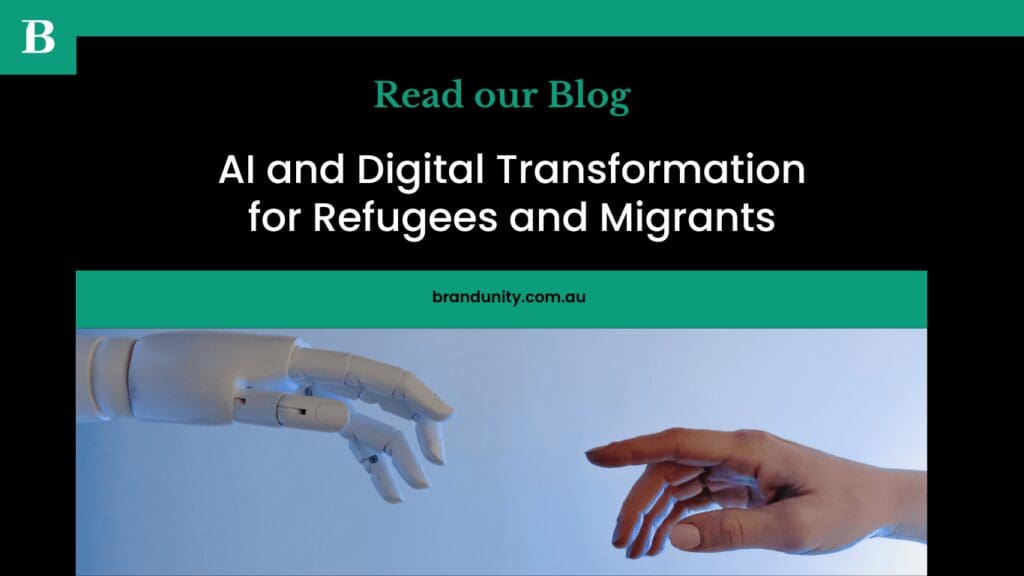As technology continues to evolve at an exponential pace, it is increasingly important that we consider how emerging technologies such as AI and digital transformation can support underserved communities such as refugees and migrants. While technology has the potential to greatly benefit these communities, many face digital literacy issues, may be less tech-savvy and are underutilising existing technologies. In this blog post, I’ll explore how AI and digital transformation can support refugee and migrant communities in technology adoption.
AI and Digital Transformation for Language Support
One of the biggest barriers to technology adoption for refugees and migrants is the language barrier. AI and digital transformation can help to overcome this challenge by providing language support. For example, AI-powered translation tools can translate websites, documents, and other digital content into multiple languages, making it more accessible to non-native speakers.
AI and Digital Transformation for Education and Training
Another way that AI and digital transformation can support refugee and migrant communities is through education and training. Online courses and training programs can be accessed remotely, allowing refugees and migrants to learn new skills and knowledge from the comfort of their own homes. AI can also be used to personalise learning experiences, tailoring content to individual needs and abilities.
AI and Digital Transformation for Employment Opportunities
Finally, AI and digital transformation can help to create new employment opportunities for refugees and migrants. For example, AI-powered platforms can match refugees and migrants with job opportunities that suit their skills and experience, regardless of language barriers or location.
AI and digital transformation have the potential to greatly benefit refugee and migrant communities by overcoming barriers to technology adoption, providing language support, offering education and training opportunities, and creating new employment opportunities.
The majority of these considerations however all are rooted in the use of access and literacy… so let’s expand our thinking….
There are other challenges that refugees and migrants face in technology adoption. It is important to consider how AI and digital transformation can support the organisations and service providers that work with these communities. Potential discussions…
How can AI and digital transformation be used to support social service organizations that work with refugees and migrants? For example, can chatbots be used to provide information and assistance in multiple languages?
How can they be used to improve communication between refugees and migrants and the organisations that serve them? For example, can machine learning algorithms be used to identify patterns in communication and improve response times?
Can blockchain technology be used to secure personal information and prevent identity theft? The decentralised nature of blockchain technology provides a high level of security, transparency, and trust, making it a promising solution for various industries seeking to improve data integrity and reduce the need for intermediaries.
How can AI and digital transformation be used to support mental health and wellbeing for refugees and migrants? Can virtual reality be used to provide therapeutic interventions?
Supporting Social Service Organisations
How can AI and digital transformation be used to promote cultural competency among service providers working with refugees and migrants? For example, can machine learning algorithms be used to analyse cultural nuances and provide tailored training for service providers?
In addition to the importance of AI and digital transformation in supporting underserved communities, it is crucial to also consider how we can improve user experiences and reduce barriers to access. One key area for improvement is the process of verification and form filling, which can often be time-consuming and frustrating for users.
One of the great advantages of virtual assistants like Alexa and Siri is that language isn’t a barrier. These assistants can understand and respond to a variety of languages, making them accessible to people from diverse linguistic backgrounds.
However, while language may not be a barrier, there are other challenges that virtual assistant tech may face when interacting with varying users. To ensure that virtual assistants are truly inclusive and accessible to all, it’s important to consider how they can be designed with trauma-informed and culturally competent principles in mind. This may include providing options for users to select their preferred cultural and linguistic norms, or offering resources and support for users who may have experienced trauma or have unique communication needs.
We need to continue to develop and improve technology with everybody in mind, prioritise user experience and consider the needs and experiences of all users, including those from underserved communities. I invite readers to share their thoughts and ideas that are truly inclusive and accessible to all.
Read this create article about Empowering local communities using artificial intelligence.
Contact Us to continue the conversation
